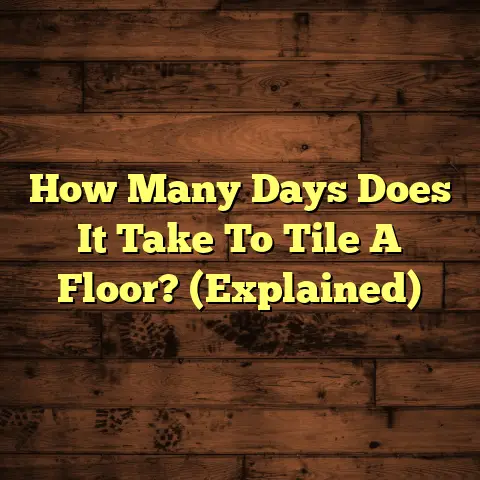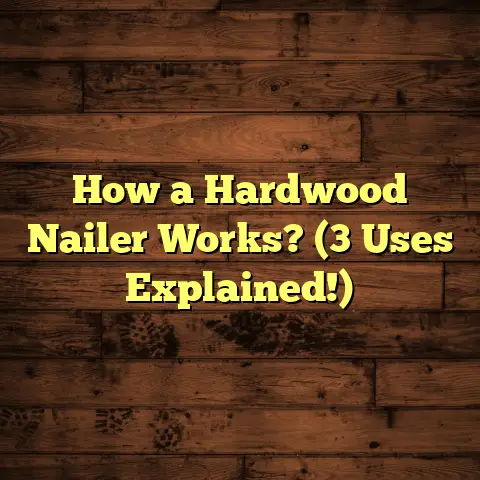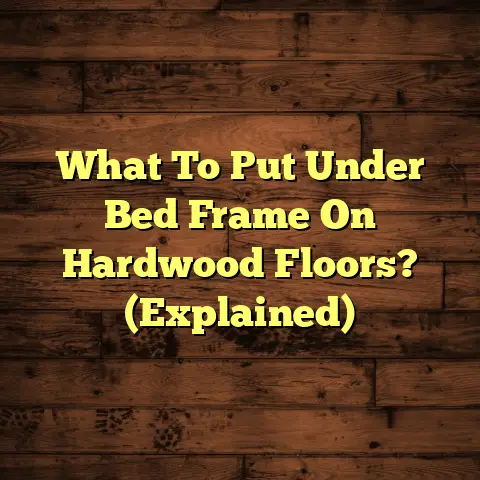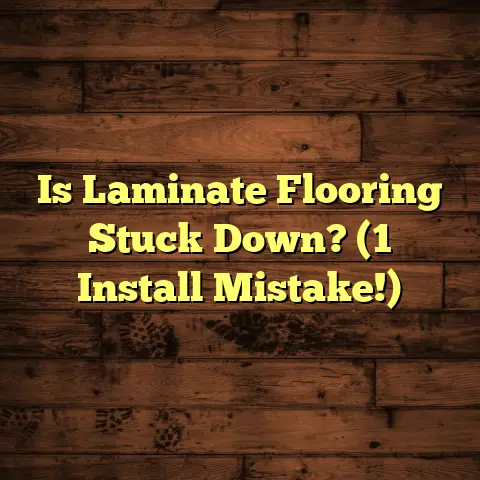Concrete Floors Like Wood? (4 Style Secrets!)
But before we get into the stylish secrets, let’s talk safety.
It’s crucial. When dealing with concrete, especially during installation, safety is paramount.
Think about it: slip resistance, proper installation techniques, and even the dust generated during the process can all pose risks.
So, let’s make sure we’re keeping safety top of mind as we explore these awesome flooring options!
Section 1: Understanding Concrete Floors
So, what exactly are concrete floors?
Simply put, they’re floors made from, well, concrete!
But it’s not just the gray stuff you see on sidewalks. Concrete flooring has come a long way.
We’re talking about specially formulated mixes, advanced sealing techniques, and even the ability to add color and texture.
Over the years, concrete flooring technology has evolved dramatically. It’s been adapted to mimic almost any material, including, you guessed it, wood!
Why choose concrete?
Well, the benefits are numerous: * Durability: Concrete is incredibly tough and can withstand heavy foot traffic. * Maintenance: It’s relatively easy to clean and maintain. * Versatility: You can customize it with colors, textures, and patterns.
Section 2: The Appeal of Wood-like Concrete Floors
Why are homeowners increasingly drawn to wood-like concrete floors?
It’s all about that aesthetic appeal!
They offer the warmth and beauty of wood without the drawbacks.
Plus, there are some serious environmental benefits.
Think about it: traditional hardwood flooring requires harvesting trees, which can contribute to deforestation.
Concrete, on the other hand, is often made with recycled materials and requires less energy to produce.
According to the Portland Cement Association, cement production (a key ingredient in concrete) has been working to reduce its carbon footprint through various initiatives, including using alternative fuels and improving energy efficiency.
And let’s not forget about the cost!
Concrete floors are often more cost-effective than hardwood, both in terms of initial installation and long-term maintenance.
Hardwood can be expensive to install, and refinishing can add up over time.
Concrete, when properly sealed, requires minimal upkeep.
Section 3: Style Secret #1: Color and Staining Techniques
Alright, let’s get into the juicy stuff: how to make concrete floors actually look like wood!
The first secret? Color and staining.
You’ve got a whole rainbow of color options available.
You can replicate the look of oak, walnut, cherry, maple, you name it!
The trick is to use concrete stains that penetrate the surface and create a realistic wood-like hue.
There are two main types of stains I usually work with:
- Acid Stains: These react chemically with the concrete, creating unique, mottled effects.
- Water-Based Stains: These offer more consistent color and are environmentally friendly.
Tip: When selecting a color, consider the overall decor style of your home.
A warm, reddish-brown stain will complement a rustic or traditional design, while a cooler, gray-toned stain will work well in a modern space.
I’ve seen some amazing transformations using these techniques.
For example, I once worked on a project where we used a combination of acid stain and a custom stencil to create a reclaimed wood look.
The client was blown away!
Section 4: Style Secret #2: Texture and Finish
Color is important, but texture is what really sells the wood-like illusion.
Think about it: real wood has grain, knots, and variations in texture.
You can mimic these features in concrete using a variety of techniques.
One popular method is to use stamping tools to create a wood-grain pattern on the surface of the concrete.
These tools come in a variety of designs, from wide planks to narrow strips.
Another option is to use hand-tooling techniques to create a more subtle, organic texture.
This involves using chisels, trowels, and other tools to carve lines and grooves into the concrete.
Once you’ve achieved the desired texture, it’s time to consider the finish.
The finish is the final layer of protection that you apply to the concrete to enhance its appearance and durability.
Here are a few popular options:
- Matte: This finish has a low sheen and provides a natural, understated look.
- Satin: This finish has a slightly higher sheen than matte and offers a more polished appearance.
- Glossy: This finish has a high sheen and creates a dramatic, reflective surface.
Tip: For a natural look that closely resembles hardwood flooring, I recommend a matte or satin finish.
I once worked on a project where we used a custom blend of stains and texturing techniques to create a concrete floor that looked exactly like reclaimed barn wood.
It was so realistic that people couldn’t believe it wasn’t the real thing!
Section 5: Style Secret #3: Layout and Design
Okay, you’ve got the color and texture down. Now it’s time to think about layout and design.
The way you arrange your concrete floors can have a big impact on their overall appearance.
One popular option is to lay the concrete in a plank-style pattern, similar to traditional hardwood floors.
This involves creating long, narrow strips of concrete and arranging them in parallel rows.
Another option is to use a herringbone pattern, which creates a more dynamic and visually interesting look.
This pattern involves arranging the concrete in a series of V-shapes, creating a zig-zag effect.
Tip: To enhance the wood-like appearance of your concrete floors, consider using rugs and furniture placement strategically.
Rugs can add warmth and texture to the space, while furniture can help define different areas and create a sense of flow.
For example, I often recommend using a large area rug in the living room to anchor the space and add a touch of coziness.
In the dining room, a long, narrow rug can help define the dining area and protect the concrete from scratches.
Section 6: Style Secret #4: Maintenance and Care
Alright, you’ve got your beautiful, wood-like concrete floors installed. Now what?
The key to keeping them looking their best is proper maintenance and care.
Concrete floors are relatively easy to maintain, but there are a few things you should keep in mind.
First, it’s important to clean your concrete floors regularly to prevent dirt and grime from building up.
I recommend sweeping or vacuuming your floors at least once a week, and mopping them with a mild detergent and water as needed.
Avoid using harsh chemicals or abrasive cleaners, as these can damage the sealant and dull the finish.
Second, it’s important to reseal your concrete floors every few years to protect them from stains and moisture.
The frequency with which you need to reseal your floors will depend on the type of sealant used and the amount of traffic they receive.
Tip: When cleaning your concrete floors, be sure to use products that are specifically designed for concrete.
These products are formulated to be gentle on the sealant and won’t leave behind any residue.
I always recommend using a pH-neutral cleaner to avoid damaging the concrete.
Here’s a quick guide to cleaning:
| Task | Frequency | Products |
|---|---|---|
| Sweeping/Vacuuming | Weekly | Broom, Vacuum with soft brush attachment |
| Mopping | As needed | pH-neutral cleaner, Water |
| Resealing | Every 2-3 years | Concrete sealant |
By following these simple maintenance tips, you can keep your concrete floors looking beautiful for years to come.
Conclusion
So, can concrete floors really look like wood? Absolutely!
With the right color, texture, layout, and maintenance, you can achieve the warmth and beauty of wood without the drawbacks.
Remember, safety should always be your top priority when working with concrete.
Take the time to research proper installation techniques and use appropriate safety equipment.
And don’t forget to have fun with the design process!
Experiment with different colors, textures, and patterns to create a unique look that reflects your personal style.
I hope this article has inspired you to consider concrete floors for your next flooring project.
They’re a durable, versatile, and stylish option that can add value and beauty to your home.
Happy flooring!





